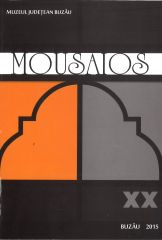Două piese din secolele VI –VII p. Chr. descoperite la Traian (jud. Neamţ)
Two pieces from VIth-VIIth century, discovered at Traian (Neamţ county)
Author(s): George-Dan HânceanuSubject(s): Archaeology
Published by: Muzeul Judetean Buzău
Keywords: Traian; Săbăoani; Neamţ; mould; clay; cross; lead; VIth-VIIth century
Summary/Abstract: In the 1990’s the settlement attributed to the VIth-VIIth century from Traian, Săbăoani commune, Neamţ county was systematically researched. The site is located in an area well known for its archaeological remains which can be dated from Neolithic to the Middle Age. It is a friendly geographical environment, especially on the Siret terraces which allowed successive settles of the human communities. The research of the Traian settlement occasioned the discovery of two, both important and interesting, pieces for the specialists. In 1995, the inventory of the house no. 9 included a lead cross and in 1998 inside the house no. 14 was discovered a clay mould designed to realize an ornament jewelry. The cross has the central bar longer (with the clinging perforation) while the lateral bars are symmetrical. The decoration consists of several striations. Dimensions: length – 30 mm; width – 23 mm; thickness – 3 mm and weight – 4,15 g. Unlike the cross, the mould is broken and suggests its utilization for the manufacture of a pendant of ear ring. Dimensions of the mould: length – 42 mm; width – 55 mm and thickness – 5 mm; dimensions of the pendant mould: length – 20 mm and width – 15 mm. Both objects from Traian are pieces of byzantine origin or influence and belong to the collections of the History Museum in Roman.
Journal: Mousaios
- Issue Year: 2015
- Issue No: 20
- Page Range: 123-132
- Page Count: 10
- Language: Romanian

